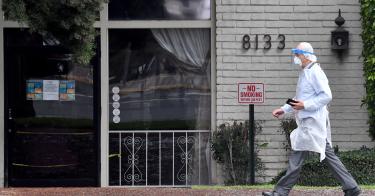When COVID-19 first reached America nearly a year ago, we knew very little about it—what it did, whom it affected most, or even whether human-to-human transmission was common. But one of the few things we knew for certain was that this virus—SARS-CoV-2, to use its technical name–was particularly dangerous to older Americans.
As early as March 18, the CDC was citing figures showing the vast majority of mortality from COVID-19 was among those 65 years and older, so nursing homes and the elderly should have been the main focus of our pandemic response since then.
But they weren't. And with nursing home cases on the rise, we need to change course—now.
>>> COVID-19 Public Policy Solutions
According to an Associated Press report, there has been a four-fold rise in nursing home-related cases of COVID-19 since June. And CDC data shows there has been an increase of nearly 1,000 COVID-related deaths in nursing homes from September to October.
There are three ways for COVID-19 to enter a nursing home: 1.) through staff and faculty working at the facility, 2.) through visitors who enter the premises, and 3.) through forcing nursing homes to admit patients with active infections.
The disastrous effects of the latter policy is one reason that Gov. Andrew Cuomo's New York has contributed a disproportionate share of American COVID-related deaths. Thankfully, his order was finally reversed in May.
The more recent increase in nursing home cases are likely a function of the former two ways that COVID enters a nursing home. This is where we need to focus our efforts, with refined policies.
Test nursing home visitors. Current guidance from the Centers for Medicare and Medicaid Services restrict the number of visitors in ways that are lacking. The focus is temperature checks and screening questionnaires, as well as observing for signs or symptoms of illness.
This may have been reasonable early on in the pandemic, when any sort of a screen was better than no screen, but it's insufficient now. We have had point-of-care testing for months now, and more recently, rapid antigen tests that require no special lab equipment, no specialized storage, not even refrigeration.
No effort should be spared in procuring what is needed to test everyone going into a nursing home, whether visitor or staff. Key to making this work: the FDA should lift restrictions requiring all tests to reviewed at a lab, so rapid tests that don't need lab equipment can truly live up to their promise.
Stronger mitigation measures for nursing home staff. It is likely that infected staff are driving the rise in cases, as visitations are relatively restricted. The AP report shows a proportionate increase in the number of staff cases and resident cases. This is naturally difficult to control because the staff live in the community and work in the nursing homes. Their job is vital.
The latest CMS guidance on staff testing frequency are intended to test often enough to detect cases early enough to stop transmissions, from staff to residents.
Clearly that hasn't been enough. We need more targeted testing to detect early cases, and that has to be done every time someone leaves and reenters the nursing home. This may be difficult for some facilities, especially rural ones, that lack either financial or human resources, but again, no effort should be spared to enable nursing homes to test everyone going to visit or who works with our elders.
>>> Politicians Embracing Lockdown Tactics Should Be Required to “Show Their Work”
Ensuring a steady and abundant supply of tests is one solution, but nursing home leadership should consider providing for housing for staff for several days at a time to obviate the need to go into the community where there may be high levels of COVID-19. Such an isolation "bubble" was good enough for the National Basketball Association, so it ought to be good enough for older Americans.
If a facility cannot manage these steps on their own, they should receive help, post haste. Every mayor and governor should immediately ask nursing home leaders for their plans, and to identify any barriers. If helped is needed, they need to arrange for its provision.
The primary focus of our COVID response should center on helping those known to be most at risk from the virus—nursing homes, the elderly and the vulnerable, and those who work with them. Anything else, especially now, would be unconscionable.
This piece originally appeared in ArcaMax



